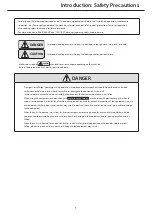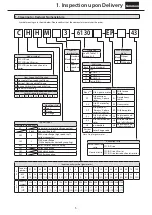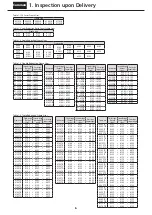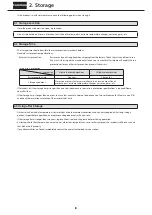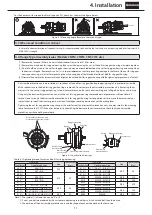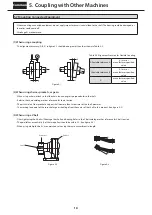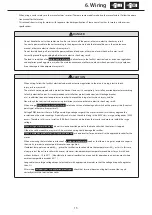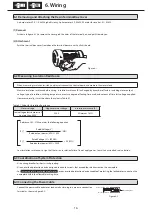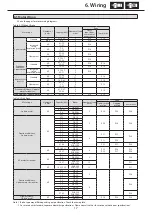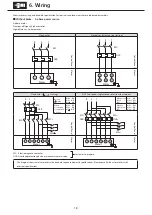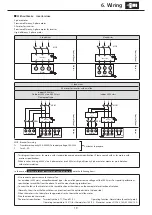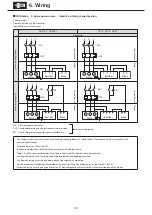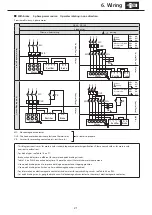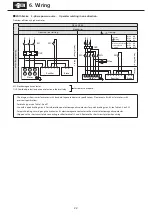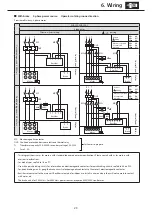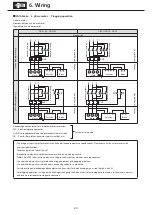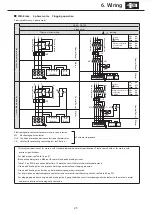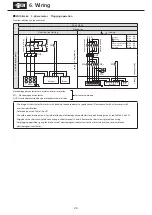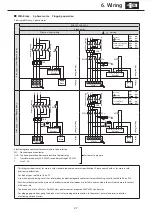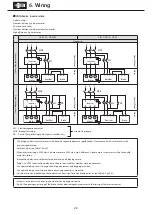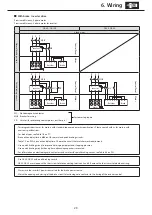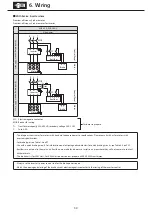
15
14
6. Wiring
14
When using a vector motor, or other manufacturer’s motor (There are some models made by other manufacture.), follow the opera-
tion manual for that motor.
This manual shows wiring for motors with Japanese standard specifications. Please consult with us for motors with overseas
specifications.
DANGER
- Do not handle the unit when cables are live. Be sure to turn off the power; otherwise, electric shock may result.
- Connect a power cable to the unit according to the diagram shown inside the terminal box or in the maintenance
manual; otherwise, electric shock or fire may result.
- Do not forcibly bend, pull, or clamp the power cable and lead wires; otherwise, electric shock or fire may result.
- Correctly ground the grounding bolt; otherwise, electric shock may result.
- The lead-in condition of an
explosion proof motor
shall conform to the facility's electrical codes, extension regulations
and explosion proofing guide, as well as the maintenance manual; otherwise, electric shock, personal injury, explosion,
fire or damage to the equipment may result.
CAUTION
- When wiring, follow the facility's electrical codes and extension regulations; otherwise, burning, electric shock,
injury, or fire may result.
- The motor is not equipped with a protection device. However, it is compulsory to install an overload protector according
to facility electrical codes. It is recommended to install other protective devices (earth leakage breaker,
etc.), in addition to an overload protector, in order to prevent burning, electric shock, injury, and fire.
- Never touch the terminals when measuring insulation resistance; otherwise, electric shock may result.
- When using a
When using a star-delta starter
select one with an electromagnetic switch on the primary side (3-contact
point type); otherwise, fire may result.
- Voltage PWM inverters that use IGBT generate high-voltage surges at the motor terminals, which may degrade the
insulation on the motor windings. Especially such as when the cable is long in the 400V class, a surge voltage over 1300V
occurs. Therefore, in this case, install an LCR filter, AC reactor, etc. between the inverter and motor to inhibit the surge
voltage.
-
When using a motor with brake
, do not turn on connection power to the brake coil when the motor is stopped.
Otherwise coil burnout fire, may result. Also, mistaken wiring could damage the rectifier.
-
When a explosion proof motor is driven by an inverter
, use one inverter for one motor. Use the approved inverter for the
motor.
- When measuring the insulation resistance of a
explosion proof motor
, confirm that there is no gas or explosive vapor in
the vicinity, in order to prevent possible explosion or ignition.
- If ambient temperature exceeds 60
℃
, place the rectifier in a location where the temperature is 60
℃
or less. In this case,
always protect the entire rectifier with a cover. However, standard ambient temperature conditions for units with and
without brakes is −10 to 40
℃
. (Manufacture to special specification is required for operation in an environment where
ambient temperature exceeds 40
℃
.)
- Long cables cause large voltage drops. Select cables with appropriate diameter so that the voltage drop will no greater
than 2%.
- After wiring
outdoor types and explosion proof types
, check that terminal box mounting bolts are not loose, and
correctly attach the terminal box cover.

